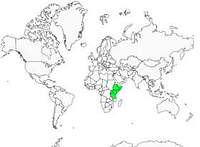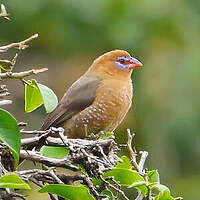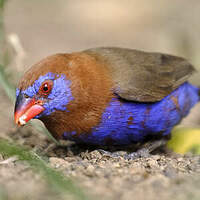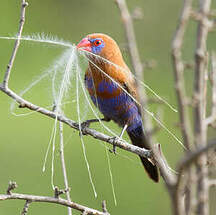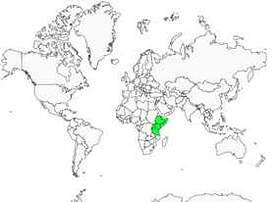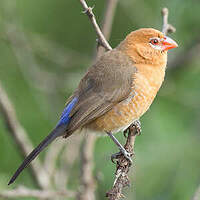Purple Grenadier
Granatina ianthinogaster - Cordonbleu violacé
Identification
The Purple Grenadier sparkles with its bright colors, particularly the male which, as indicated by its name, has colors that give it a purple hue, resulting from a visual mix of blue and red from a distance. The species indeed shows sexual dimorphism. The adult male has a head and neck of cinnamon color, except for a large bright blue eye-ring. The eye with a dark red iris is surrounded by an equal red eye-ring. The bill, conical with culmen and gonys slightly curved, is red-coral, often with the culmen somewhat gray. The mantle, back and wings are of a rather cold grayish brown. The rump and upper tail-coverts are blue. The tail is black with a bit of blue at its base. The underparts are of a deep cobalt blue, with cinnamon yellow accents in the form of a breast band more or less distinct, and often in the form of patches at the throat, lower chest and belly with a great individual variability. The legs are gray. The adult female has the upperparts identical to the male. She is distinguished mainly by the lack of blue on the underparts, but also by less blue around the eye. The cinnamon red hue on the head reaches the underparts, mostly the chest and sides which show spotted/barred pale markings, and often on the throat and belly in the form of patches, again with great individual variability. The belly and underside can be white. The juvenile is similar to the female but with a duller plumage. The bright cinnamon red is replaced by a uniform reddish fawn. The eye-ring is whitish to bluish white. The bill is darkened. As in the Red-cheeked Cordonbleu, a partial molt of the head occurs at a very young age. When the adult looking head is formed, the upper jaw is still black and the lower one red-orange.The rest of the plumage is still juvenile. There are considerable individual variations and many intermediate plumages.
Subspecific information monotypic species
Foreign names
- Cordonbleu violacé,
- Granadero oriental,
- granadeiro-púrpura,
- Veilchenastrild,
- bíbormellű pillangópinty,
- Blauwbuikgranaatastrild,
- Granatino viola,
- violastrild,
- Purpurastrild,
- motýlik modrobruchý,
- motýlek modrobřichý,
- Violbuget Granatastrild,
- kobolttipeippo,
- bec de corall porpra,
- motylik niebieskobrzuchy,
- Фиалковый астрильд,
- ムラサキトキワスズメ,
- 紫蓝饰雀,
- violastrild,
- 紫藍飾雀,
Voice song and call
The calls consist of rapid repetition of high notes like tsit, psit, tit and variations. With excitement, the emission can approach trill. You can also hear some very sharp sits. The alarm call is a sharp clicking. The song is a melodic and varied babble usually ending in trill. This song is reminiscent of the song of our Melodious Linnet. Both sexes sing. Each male has its own repertoire. There are also geographical variations.
Habitat
The Purple Grenadier lives and nests in arid to semi-arid areas from sea level to 1600 meters above sea level in Ethiopia and up to 2300 meters in East Africa. Its habitat includes thorny bushes, acacia groves, open forests with grassy areas, and even cultivated fields. It particularly appreciates aloe and sometimes more open bushes.
Behaviour character trait
The Purple Grenadier is peaceful outside of the breeding season, however it can become aggressive in the presence of Red-cheeked Grenadiers, and sometimes but more rarely with other Estrildidae on the same area.
Rather unafraid, it easily accepts the presence of people, yet it is rather discreet. It feeds on the ground near thickets and undergrowth, usually alone or in a couple but can form small groups. The species is strictly sedentary. Both the male and female sing out loud, sometimes calling back from one perch to another.Dietfeeding habits
Reproduction nesting
The breeding season coincides with the rainy season. The territorial male, equipped with a twig or a feather in its beak, seduces the female by hopping around her.
Standing upright on its feet, it performs small head movements from side to side while singing. The consenting female approaches the male and participates in the parade. Male and female share the construction of the nest placed in a fork of a low bush or in the middle of tall grasses under a dense vegetation cover. Round in shape with a lateral entrance, it is built of dry grass, vegetable fibers and is lined inside with feathers. The female lays 3 to 5 eggs that she incubates alone once the 4th or 5th is laid. During this period, the male brings continuously feathers inside the nest. The young are mainly fed with insects. When they reach the flying stage, at 21 days old, the parents call them outside the nest with food in their bill. The latter then remain dependent on the adults for two weeks. The adults can raise three broods per year. Sensitive and subject to stress, the Purple Grenadier can abandon the nest at the slightest disturbance. It has been proven that the species can be parasitized by the Paradise Widow.Geographic range
Threats - protection
Sources of information
- IOC World Bird List (v14.2), Gill, F and D Donsker (Eds). 2024-04-18.
- Finches and Sparrows, Peter Clement
- Birds of East Africa: Kenya, Tanzania, Uganda, Rwanda, Burundi, Terry Stevenson, John Fanshawe
- Birds of the Horn of Africa, Nigel Redman
- HBW Alive,
- Finch Information Center,
- xeno-canto, Sharing bird sounds from around the world,
Other sources of interest
 Specification sheet created on
20/07/2023 by Nathalie Santa Maria
Specification sheet created on
20/07/2023 by Nathalie Santa MariaTranslation by AI Oiseaux.net
© 1996-2025 Oiseaux.net
- Accipitriformes
- Aegotheliformes
- Anseriformes
- Apodiformes
- Apterygiformes
- Bucerotiformes
- Caprimulgiformes
- Cariamiformes
- Casuariiformes
- Charadriiformes
- Ciconiiformes
- Coliiformes
- Columbiformes
- Coraciiformes
- Cuculiformes
- Eurypygiformes
- Falconiformes
- Galliformes
- Gaviiformes
- Gruiformes
- Leptosomiformes
- Mesitornithiformes
- Musophagiformes
- Nyctibiiformes
- Opisthocomiformes
- Otidiformes
- Passeriformes
- Pelecaniformes
- Phaethontiformes
- Phoenicopteriformes
- Piciformes
- Podargiformes
- Podicipediformes
- Procellariiformes
- Psittaciformes
- Pterocliformes
- Rheiformes
- Sphenisciformes
- Steatornithiformes
- Strigiformes
- Struthioniformes
- Suliformes
- Tinamiformes
- Trogoniformes


